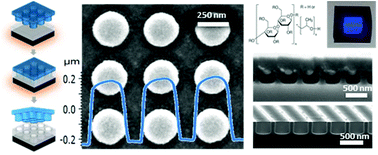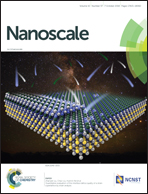A water-processable cellulose-based resist for advanced nanofabrication†
Abstract
The ideal nanofabrication technique is one that allows the mass production of high resolution submicrometric features in a cost efficient and environmentally friendly fashion. A great step towards achieving this goal has been the development of nanoimprinting lithography, a procedure with tenths of nanometres resolution while being compatible with roll-to-roll manufacturing. However, an ecofriendly resist that can be efficiently combined with this process is still missing. In this work, we demonstrate the use of hydroxypropyl cellulose (HPC) as a biocompatible, biodegradable, and water processable resist for temperature assisted nanoimprint lithography (tNIL) by fabricating different photonic architectures. The cellulose derivative is easily patterned with submicrometric features with aspect ratios greater than 1 using an elastomeric stamp and a hot plate. Silicon photonic crystals and metal nanoparticle arrays are fabricated combining cellulose with traditional nanofrabrication processes such as spincasting, reactive ion etching and metal lift off. Furthermore, advanced nanofabrication possibilities are within reach by combining the HPC with traditional resists. In particular, poly(methyl methacrylate) and HPC stacks are easily produced by liquid phase processing, where one of the two materials can be selectively removed by developing in orthogonal solvents. This capability becomes even more interesting by including nanoimprinted layers in the stack, leading to the encapsulation of arrays of air features in the resist.



 Please wait while we load your content...
Please wait while we load your content...